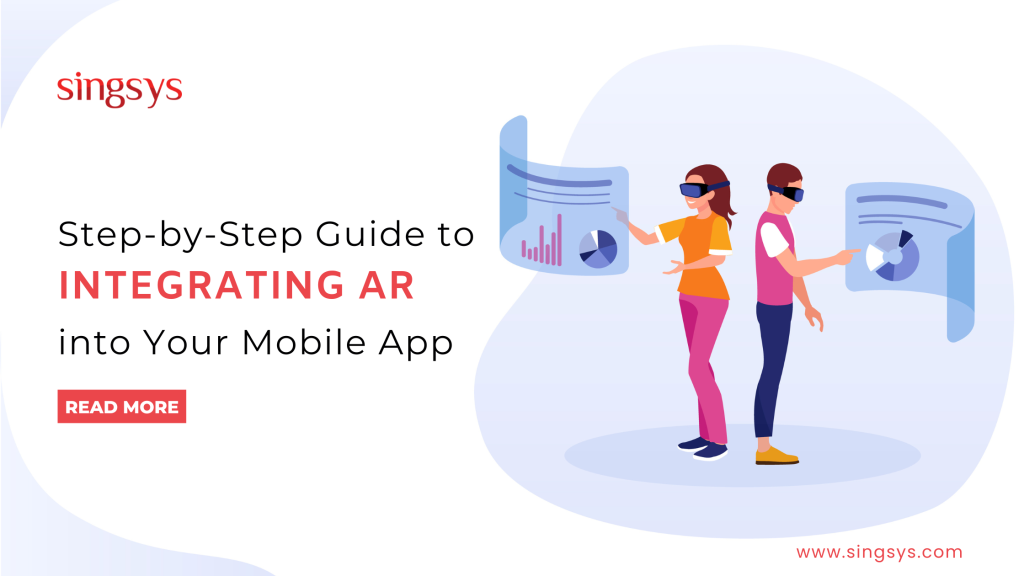Most Profitable AI Business and Startup Ideas to Watch in 2026
Artificial Intelligence (AI) is now more than just a trendy term; it is key to driving innovation, efficiency, and profit in many industries. By 2026, AI will change how businesses […]

Augmented Reality (AR) has rapidly evolved from being a futuristic concept to a mainstream technology that transforms how users interact with mobile apps. From gaming and e-commerce to healthcare and education, AR creates immersive experiences that blend the physical and digital worlds.
As the global AR market is projected to exceed $88 billion by 2030, businesses are increasingly exploring ways to incorporate AR into their mobile strategies.
This detailed guide walks through every step of integrating AR into a mobile app — from understanding the technology and setting clear goals to development, testing, and future optimisation.
Augmented Reality overlays digital content, such as images, 3D models, or text, onto the real world using a smartphone or tablet camera. Unlike Virtual Reality (VR), which immerses users in a fully digital environment, AR enhances the existing world by adding interactive digital layers to it.
For example, Pokémon Go revolutionised gaming by using AR to bring virtual creatures into real-world locations. Similarly, IKEA Place allows users to visualise furniture in their homes before purchasing, while educational apps use AR to help students explore complex topics through 3D visualisations.
AR operates through sensors, cameras, motion tracking, and AI algorithms to understand the environment and project digital elements in real time, offering users a seamless, interactive experience.
Integrating AR into your app isn’t just a trend — it’s a powerful way to elevate engagement, retention, and brand loyalty. Here’s why it matters:
Prerequisites for AR Integration
Before jumping into development, a few key decisions and preparations are necessary:
Every successful AR project begins with a clear goal.
Ask yourself:
Selecting the right development framework can determine the app’s success.
When choosing tools, consider cost, learning curve, and the platform’s long-term support.
Designing for AR is different from traditional mobile interfaces.
Users interact with virtual objects in physical space, so your design should feel natural and intuitive.
A well-designed AR experience ensures that the technology enhances rather than distracts from your app’s core purpose.
With objectives, tools, and designs in place, the next step is coding and implementation.
Developers integrate AR frameworks, set up 3D models, and configure tracking systems.
Examples include:
Testing during development ensures accurate rendering, stable performance, and minimal lag.
Testing is crucial because AR depends heavily on real-world conditions.
Conduct testing across multiple devices, lighting environments, and physical spaces to ensure reliability.
Check for:
Beta testing with real users provides valuable feedback to refine usability before launch.
Once testing is complete, launch your AR app on the appropriate app stores.
Use analytics tools to monitor how users engage with AR features — how long they interact, what they explore, and what challenges they face.
Update your app regularly to improve tracking accuracy, add new AR features, and stay compatible with evolving SDKs and OS updates.
User feedback should guide future optimisations and feature enhancements.
While AR offers enormous potential, it comes with challenges that developers must navigate:
Understanding these limitations early can help teams plan efficiently and deliver a stable, high-performing AR app.
The future of AR looks incredibly promising. With advancements in AI, 5G, and spatial computing, AR will soon deliver even more realistic, intelligent, and interactive experiences.
Emerging trends include:
Businesses that start experimenting with AR today will be better positioned to lead in tomorrow’s digital landscape.
Augmented Reality is reshaping mobile app innovation, offering businesses endless possibilities to engage, inform, and inspire their users. By following the right steps — defining clear objectives, choosing suitable frameworks, designing intuitive UX, and testing thoroughly — you can successfully integrate AR into your app and unlock its full potential.
If your business is ready to explore the power of AR, Singsys, a leading mobile app development company, offers expert consultation and end-to-end AR integration services tailored to your needs.
Bring your ideas to life — with AR innovation that connects technology and imagination.
Disclaimer:
The information provided in this article is intended solely for general educational and informational purposes. While every effort has been made to ensure accuracy, technology and development tools evolve rapidly, and the content may not reflect the most current advancements or practices. Readers and developers are encouraged to conduct further research and seek professional advice before implementing AR solutions in their projects.
Read more blog posts:
Oct 3rd, 2025
Artificial Intelligence (AI) is now more than just a trendy term; it is key to driving innovation, efficiency, and profit in many industries. By 2026, AI will change how businesses […]
Sep 4th, 2025
Customer engagement has become the heartbeat of business success in today’s hyper-competitive market. Customers no longer stick to a brand just for its products; they stay loyal because of meaningful […]
Dec 15th, 2017
Mozilla the development team behind the popular Firefox web browser have recently released its very first augmented reality app for iOS. After the rise of Virtual Reality, it seems […]